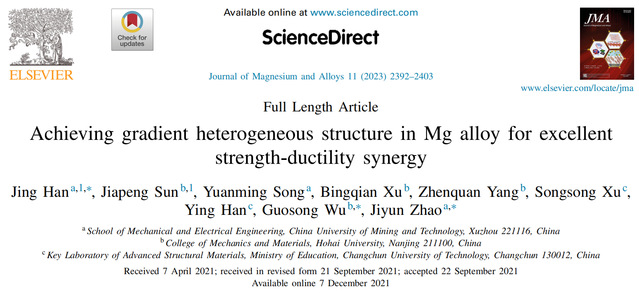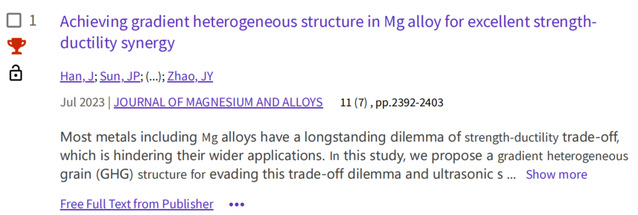

Recently, Associate Professor Han Jing and others from School of Mechanical and Electrical Engineering have made new progress in the field of surface processing. One of their achievements, titled ‘Achieving Gradient Heterogeneous Structure in Mg Alloy for Excellent Strength-Ductility Synergy’, was published in the internationally authoritative journal Journal of Magnesium and Alloys (impact factor 17.6) and was selected as an ESI highly cited paper. Associate Professor Han Jing is the first author of the paper, and Professor Zhao Jiyun and others are the corresponding authors. The second achievement, titled “Preparation, Microstructure and Properties of High-performance Gradient Nanostructured Pure Ti Plate by USSR”, was published in the domestic authoritative journal Journal of Mechanical Engineering, with Associate Professor Han Jing as the first author and Professor Zhao Jiyun as the corresponding author.
Currently, high-end equipment manufacturing in areas such as mining machinery, engineering equipment, fluid machinery, and medical devices has become a major battleground for reducing carbon emissions, and the innovation of key component manufacturing technology is one of the main ways to achieve the ‘carbon peaking and carbon neutrality’ goals. In the field of surface processing, the research group led by Han Jing has developed ultrasonic severe surface rolling (USSR) technology, making it possible to achieve synergistic processing of millimeter-scale gradient nanosurface layers and high-quality surfaces. The research results enabled the application of USSR to Mg alloys, producing ZE41 Mg alloy sheets with gradient heterogeneous structures. The yield strength of the alloy was increased by 2.9 times compared to its cast state, and the elongation was increased by 1.6 times, breaking through the long-standing dilemma of strength and plasticity being mutually exclusive in metal materials. The excellent strength-ductility combination mainly comes from the synergistic effect brought by the highly heterogeneous design of the microstructure, namely heterogeneous deformation-induced strengthening and hardening effects. After USSR, the surface roughness of Mg alloy sheet was reduced from Ra 0.078 μm in traditional rolling to Ra 0.034 μm. When USSR was applied to industrial pure titanium, high-strength, corrosion-resistant, and smoothly polished high-performance pure titanium sheets were obtained. A single process can produce a 1.3mm-thick gradient hardened layer and a mirror-like polished surface. The grain size, dislocation, and twin density inside the gradient hardened layer change with depth gradient, and the grain size of the surface layer is refined to 52.2 nm. The yield strength of the processed samples was increased by 33.8%, while maintaining a 20.8% fracture elongation, and the stability and passivation capability of the passive film were simultaneously improved.
USSR not only provides new ideas and technical support for the simultaneous improvement of the strength, plasticity, corrosion resistance, and wear resistance of mechanical engineering materials, but also can be combined or integrated with traditional manufacturing and additive manufacturing to achieve multi-functionalization, such as surface finishing, surface strengthening, surface corrosion and wear modification, and overall strengthening and plasticization of complex geometric components. It has extensive potential applications in the surface manufacturing and remanufacturing of friction pairs and key structural components in mining machinery and engineering equipment, high-water-based hydraulic components, and medical devices.